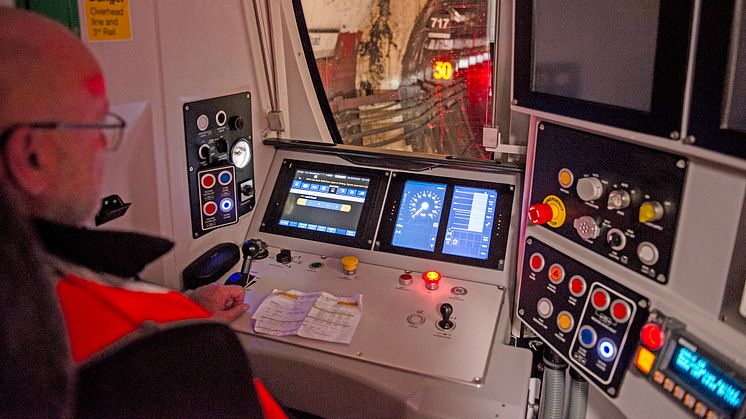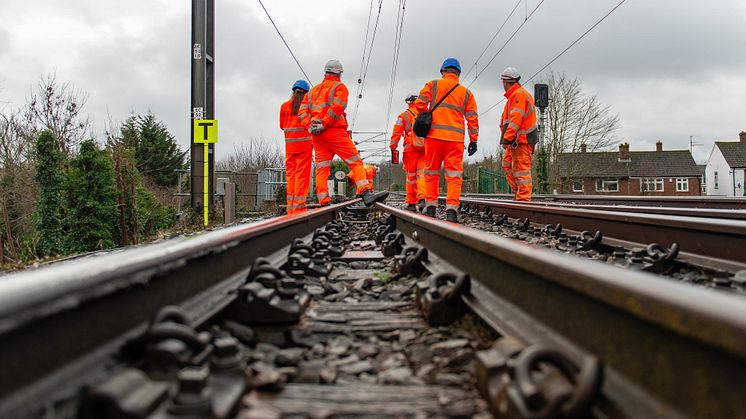
Press release -
GTR’s 717 passes ETCS software upgrade test with flying colours
Govia Thameslink Railway (GTR), with Siemens Mobility, has successfully upgraded one of its Class 717 Great Northern trains to the latest specification of the in-cab digital signalling, European Train Control System (ETCS).
It’s the latest milestone to be achieved in the ground-breaking East Coast Digital Programme.
On Monday 3 February, unit 717020 ran for the first time on the Northern City Line between Moorgate and Finsbury Park using ETCS Baseline 3, Release 2. There were no issues in this empty coaching stock trial.
It is anticipated the entire 717 fleet of 25 trains will be upgraded within the next few months. GTR is already operating all its services on the Northern City Line in ETCS, and it is planned that the signals will be physically removed in May.
The industry is working towards the introduction of digital signalling on the East Coast Main Line (ECML) as part of the government-funded East Coast Digital Programme (ECDP). This latest specification of ETCS will become the new baseline for all services operated on it by GTR and other operators, enabling them to make use of the latest digital infrastructure.
GTR’s Head of ERTMS Oly Turner said: “The East Coast Digital Programme will eventually bring huge benefits to GTR and passengers, with a more reliable, more sustainable railway, lower emissions, and even better safety for passengers.
“Working with our industry colleagues, we’ve been spearheading the introduction of ETCS and now every one of our Class 717 trains is operating in passenger service using the system on the Northern City Line.
“Now, through the joint work of many GTR departments, Siemens and Network Rail, we’ve successful trialled this latest specification of the software. This puts us in great shape for 'signals away' on the Northern City Line in May.”
Ben Lane, Infrastructure Lead and ECDP Project Director, Siemens Mobility said: “The Northern City Line project is a great example of how our technology continues to transform rail travel and transport across the UK. With our Siemens Mobility Class 717 trains linked to our very own ETCS software, we're showing how to connect track and train with integrated digital solutions.
“Working closely with Network Rail and GTR, we’ve already seen the benefits of introducing ETCS and when we move to no signals in May, these benefits will grow even further, reducing maintenance, cutting disruptions, and delivering smoother, more reliable journeys.”
Jonathan Daniels, Network Rail’s ECDP Integration Lead, said: “This successful upgrade on GTR’s Class 717 fleet establishes a new baseline level of ETCS which will be rolled out across all operators and fleets, providing services at the southern end of the East Coast Main Line. Once again, our Northern City Line pathfinder project is helping pave the way towards the ECML becoming Britain’s first intercity mainline to operate under ETCS control.”
ENDS
Editors' notes
Digital signalling
Digital signalling, using ETCS is a proven technology already in use in many countries in Europe and elsewhere. The ECDP will see the first introduction of ETCS to an intercity mainline in Great Britain, and will provide the foundation for the future expansion of digital signalling across the network. ETCS is currently in use in the central London section of Thameslink and on the Cambrian Line in Wales, and now on the Northern City Line (Finsbury Park to Moorgate), in the first stage of ECDP.
More reliability: With signalling information being provided directly to the driver, via a screen in their cab, there will no longer be a need to maintain a large amount of lineside equipment involved with traditional ‘traffic light’ signals. As a result, the amount of signalling-related engineering work will reduce in the future by around almost half. Additionally, trains are sometimes affected by signal failures; moving to a modern, digitally based system makes this less likely, potentially reducing thousands of hours of delays, and making train services more reliable.
More punctual services: Digital signalling gives train drivers continual information about the safe maximum speed for their train. It provides drivers with additional information about the route ahead, that today’s fixed ‘traffic light’ signals do not. This enables more ‘efficient’ operations, helping trains stay on time. The new technology allows continuous communication between the trackside and onboard equipment. Signallers can continuously communicate with every train on the network and respond in real time using digital tools to help smooth the flow of trains and recover services more quickly after disruption.
Greener journeys: Digital signalling contributes to a greener railway. The East Coast Main Line is already electrified, and these upgrades will deliver a further 55,000 tonne reduction in carbon emissions over 60 years – the equivalent to over 65,000 one-way flights from London to New York, or over 2 million passenger train journeys from London to Edinburgh. This is because there is much less physical equipment to produce and maintain compared with what’s needed for ‘traffic light’ signals. The estimated whole life carbon saving over a 60-year period (the expected life span of a ‘traditional’ signalling system) is around 39%. The technology also allows gentler braking, meaning journeys are smoother and use less energy. Finally, a more reliable and punctual railway will encourage more people to choose rail over road and air, ultimately reducing transport emissions for the long-term.
Topics
Categories
For more information, contact the press office on 0203 750 2031.
Govia Thameslink Railway
Govia Thameslink Railway (GTR) operates Thameslink, Great Northern, Southern and Gatwick Express services as follows:
- Thameslink – cross-London services between Bedford/Peterborough/Cambridge and Brighton/Horsham/East Grinstead, and between Luton/St Albans and Sutton/Wimbledon/Rainham; plus services between London and Sevenoaks
- Great Northern – services between London and Welwyn, Hertford, Peterborough, Cambridge and King’s Lynn
- Southern – services between London and the Sussex coast (Brighton, Worthing, Eastbourne, Bognor Regis, Hastings) and parts of Surrey, Kent and Hampshire (Ashford International, Southampton, Portsmouth)
- Gatwick Express – fast, non-stop direct services between Gatwick Airport and London Victoria
www.southernrailway.com, www.thameslinkrailway.com, www.gatwickexpress.com, www.greatnorthernrail.com

